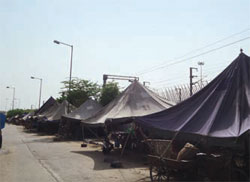It happened in Delhi too, but
earlier than usual. On the 19th
of June, the roads near the Inter
State Bus Terminal at Kashmere
Gate were inundated by water.
Every year the Yamuna floods its
banks. This year too, the Yamuna
ravaged its banks, but much earlier
than expected. The water level in
the river rose to 207.12 metres
which is 2.29 metres above the
danger mark of 204.83 metres. In
addition to that, Haryana released
over 81,000 cusecs of water into the
Yamuna from the Hathnikund
barrage on the 19th of June. The
neighbouring state had released 8
lakhs and 1.5 lakhs cusecs of water
each on the 17th and 18th of June,
respectively. The official sources
claim that 5000 people have been
evacuated and 900 tents have been
put all over the city.
 |
| Flood affected area on the Yamuna Bank |
The Yamuna Bank area, is
surrounded by stagnant flood water
now. There, we spotted a large
number of people in tents on the
stretch extending from the Yamuna
Bank Metro Station to the Metro
Official Quarters. These people had
moved to safer places near the
Yamuna Bank Metro Station on the
19th of June. The residents pitched
the tents themselves. Jagdeesh
Saini, a senior citizen told us that
they had been living in the Yamuna
Bank area since 1999. Before the
Yamuna claimed her banks recently,
these families earned upto Rs. 8000
every month from their farms and
nurseries. In the Yamuna Bank relief
camp, in the absence of government
assistance, an NGO, the Janhith
Kisaan Samiti, had been supplying
food to the affected people every
morning and evening. The Delhi Jal
Board provides water in tankers, but
the plastic cans, bottles and utensils
in which the people store their water
are filthy.
 |
| Temporary shelter |
At Majnu Ka Tila, which is very
near to the Delhi Vidhan Sabha,
Kishan Lal’s kabadi shop was
washed away in the flood. Rajendra
Kumar, a farmer stays in a camp just
outside the DDA Park along with his
family. “We know this happens every
year and so does the Government.
Why can't they take actions on time?
This will keep on happening every
year with us” he said. Half of the
DDA Park is still submerged in flood
waters.. Garbage floats around in the
park and people are cleaning it
themselves. The homes of the
Tibetan refugees are also filled with
garbage. Relief camps have come
up across GT road but can’t be used
since crossing the roads can be
risky. Mishaps are common and
recently a child got injured.
Inefficient management and
unawareness about relief schemes
add to the flood misery of Delhi. The
water released from the dams on the
upper reaches of the river Yamuna
makes life along the banks more
vulnerable. Proactive disaster
response mechanisms are nonexistent
in our country and so are
the post disaster relief measures. It’s
high time our response mechanisms
become more centralised and change
the focus from post disaster relief
and rehabilitation to disaster
mitigation and management. |
